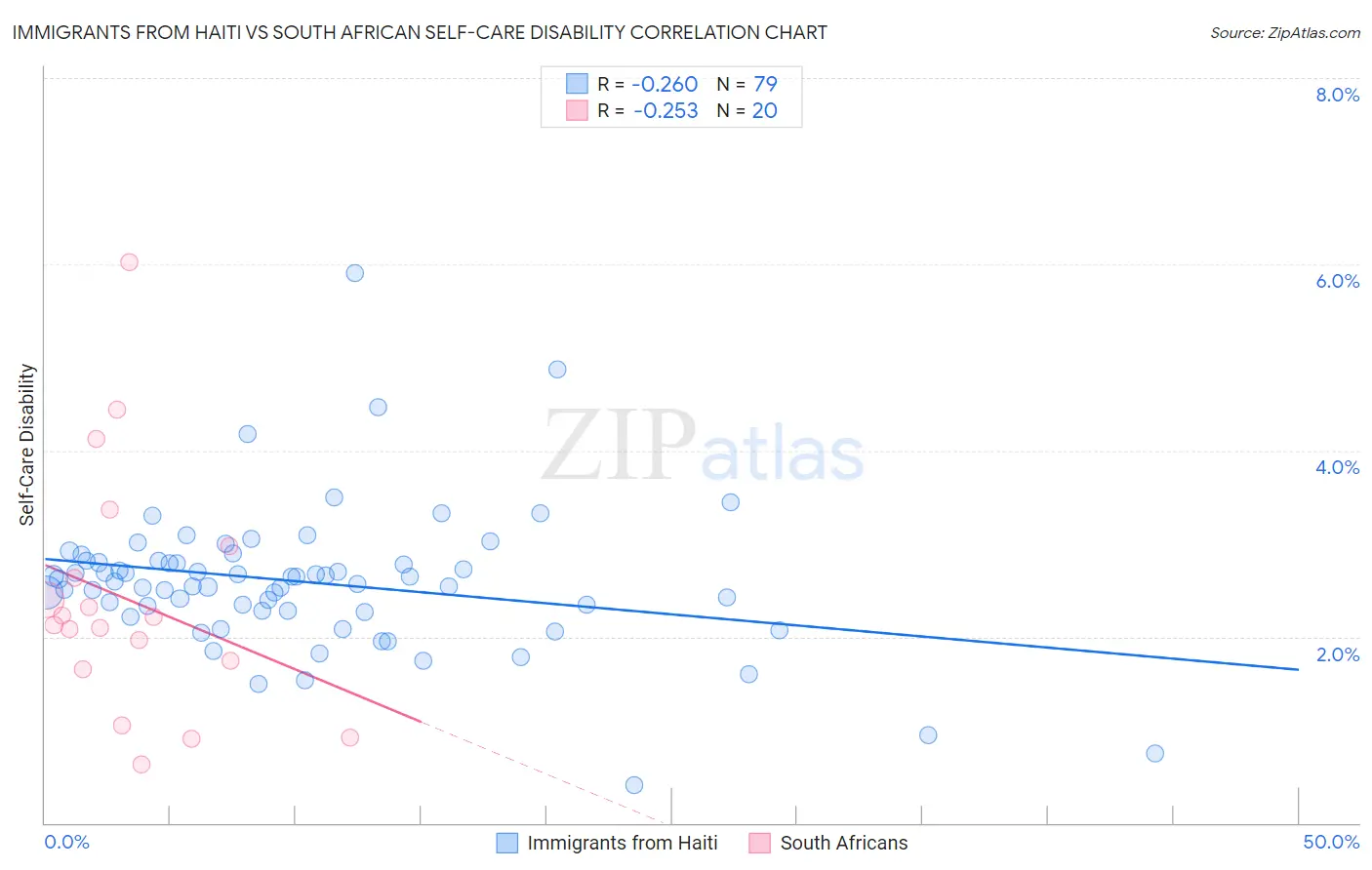Immigrants from Haiti vs South African Self-Care Disability
COMPARE
Immigrants from Haiti
South African
Self-Care Disability
Self-Care Disability Comparison
Immigrants from Haiti
South Africans
2.6%
SELF-CARE DISABILITY
0.3/ 100
METRIC RATING
253rd/ 347
METRIC RANK
2.3%
SELF-CARE DISABILITY
99.3/ 100
METRIC RATING
67th/ 347
METRIC RANK
Immigrants from Haiti vs South African Self-Care Disability Correlation Chart
The statistical analysis conducted on geographies consisting of 225,098,075 people shows a weak negative correlation between the proportion of Immigrants from Haiti and percentage of population with self-care disability in the United States with a correlation coefficient (R) of -0.260 and weighted average of 2.6%. Similarly, the statistical analysis conducted on geographies consisting of 182,494,090 people shows a weak negative correlation between the proportion of South Africans and percentage of population with self-care disability in the United States with a correlation coefficient (R) of -0.253 and weighted average of 2.3%, a difference of 13.4%.

Self-Care Disability Correlation Summary
| Measurement | Immigrants from Haiti | South African |
| Minimum | 0.41% | 0.63% |
| Maximum | 5.9% | 6.0% |
| Range | 5.5% | 5.4% |
| Mean | 2.6% | 2.4% |
| Median | 2.6% | 2.2% |
| Interquartile 25% (IQ1) | 2.3% | 1.7% |
| Interquartile 75% (IQ3) | 2.8% | 2.8% |
| Interquartile Range (IQR) | 0.53% | 1.1% |
| Standard Deviation (Sample) | 0.78% | 1.3% |
| Standard Deviation (Population) | 0.77% | 1.3% |
Similar Demographics by Self-Care Disability
Demographics Similar to Immigrants from Haiti by Self-Care Disability
In terms of self-care disability, the demographic groups most similar to Immigrants from Haiti are Haitian (2.6%, a difference of 0.020%), Tsimshian (2.6%, a difference of 0.060%), Immigrants from Bangladesh (2.6%, a difference of 0.080%), Immigrants from Central America (2.6%, a difference of 0.080%), and Immigrants from Liberia (2.6%, a difference of 0.15%).
| Demographics | Rating | Rank | Self-Care Disability |
| Cheyenne | 0.6 /100 | #246 | Tragic 2.6% |
| Immigrants | Albania | 0.6 /100 | #247 | Tragic 2.6% |
| Nicaraguans | 0.6 /100 | #248 | Tragic 2.6% |
| Mexican American Indians | 0.5 /100 | #249 | Tragic 2.6% |
| Portuguese | 0.4 /100 | #250 | Tragic 2.6% |
| Immigrants | Liberia | 0.4 /100 | #251 | Tragic 2.6% |
| Immigrants | Bangladesh | 0.4 /100 | #252 | Tragic 2.6% |
| Immigrants | Haiti | 0.3 /100 | #253 | Tragic 2.6% |
| Haitians | 0.3 /100 | #254 | Tragic 2.6% |
| Tsimshian | 0.3 /100 | #255 | Tragic 2.6% |
| Immigrants | Central America | 0.3 /100 | #256 | Tragic 2.6% |
| Potawatomi | 0.3 /100 | #257 | Tragic 2.6% |
| Immigrants | Nonimmigrants | 0.3 /100 | #258 | Tragic 2.6% |
| Immigrants | Belarus | 0.2 /100 | #259 | Tragic 2.6% |
| Chippewa | 0.2 /100 | #260 | Tragic 2.6% |
Demographics Similar to South Africans by Self-Care Disability
In terms of self-care disability, the demographic groups most similar to South Africans are Immigrants from Argentina (2.3%, a difference of 0.030%), Brazilian (2.3%, a difference of 0.060%), Immigrants from Zaire (2.3%, a difference of 0.090%), Immigrants from Norway (2.3%, a difference of 0.090%), and Swedish (2.3%, a difference of 0.12%).
| Demographics | Rating | Rank | Self-Care Disability |
| Immigrants | Japan | 99.5 /100 | #60 | Exceptional 2.3% |
| Palestinians | 99.4 /100 | #61 | Exceptional 2.3% |
| Egyptians | 99.4 /100 | #62 | Exceptional 2.3% |
| Mongolians | 99.3 /100 | #63 | Exceptional 2.3% |
| Swedes | 99.3 /100 | #64 | Exceptional 2.3% |
| Brazilians | 99.3 /100 | #65 | Exceptional 2.3% |
| Immigrants | Argentina | 99.3 /100 | #66 | Exceptional 2.3% |
| South Africans | 99.3 /100 | #67 | Exceptional 2.3% |
| Immigrants | Zaire | 99.2 /100 | #68 | Exceptional 2.3% |
| Immigrants | Norway | 99.2 /100 | #69 | Exceptional 2.3% |
| Immigrants | Northern Europe | 99.2 /100 | #70 | Exceptional 2.3% |
| Asians | 99.2 /100 | #71 | Exceptional 2.3% |
| Eastern Europeans | 99.2 /100 | #72 | Exceptional 2.3% |
| Immigrants | Egypt | 99.1 /100 | #73 | Exceptional 2.3% |
| Immigrants | Switzerland | 99.1 /100 | #74 | Exceptional 2.3% |